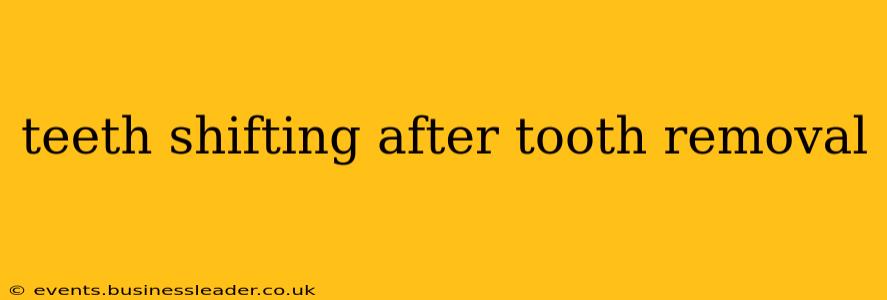Losing a tooth, whether through extraction or accident, can trigger a cascade of changes in your mouth. One common consequence is the shifting of surrounding teeth. This isn't simply a cosmetic concern; it can impact your bite, jaw alignment, and even your overall oral health. Understanding why teeth shift, how to manage the process, and what preventative measures you can take is crucial for maintaining a healthy and functional smile.
Why Do Teeth Shift After Tooth Removal?
Teeth are remarkably dynamic structures, constantly adjusting to the forces acting upon them. When a tooth is removed, the surrounding teeth lose the support and pressure provided by their neighbor. This creates a void that the remaining teeth naturally try to fill, leading to gradual shifting. Think of it like a row of dominoes; removing one disrupts the entire alignment.
How Significant is the Shifting?
The degree of shifting varies depending on several factors:
- Location of the missing tooth: Teeth in the front are more prone to significant shifting due to the pressure of the tongue and lips.
- Adjacent teeth: The health and stability of the teeth next to the gap influence how much they move.
- Bone structure: Adequate bone support is crucial in maintaining tooth position. Bone loss can exacerbate shifting.
- Time since extraction: The longer the gap remains unaddressed, the more likely the surrounding teeth are to shift significantly.
What are the Long-Term Effects of Teeth Shifting?
Ignoring tooth shifting after extraction can lead to several problems:
- Malocclusion (bad bite): This can make chewing difficult and lead to temporomandibular joint (TMJ) disorders.
- Increased risk of periodontal disease: Shifting can create spaces where food particles accumulate, leading to gum inflammation and infection.
- Aesthetic concerns: Gaps and misaligned teeth can negatively impact your smile's appearance.
- Difficulty with speech: In some cases, significant shifting can affect pronunciation.
How Can I Prevent Teeth Shifting After Tooth Extraction?
Proactive measures are key to minimizing tooth movement. Here are some important steps:
- Consult your dentist promptly: Discuss your options for replacing the missing tooth as soon as possible.
- Consider immediate replacement: Implants, bridges, or temporary dentures can help maintain the space and prevent shifting.
- Maintain good oral hygiene: Brushing and flossing regularly help prevent gum disease and maintain the health of your teeth and gums, contributing to overall stability.
What are My Options for Replacing a Missing Tooth?
Several options exist for replacing a missing tooth, each with its advantages and disadvantages:
- Dental Implants: These are artificial tooth roots surgically placed into the jawbone. They provide a strong and stable foundation for a replacement tooth.
- Dental Bridges: These are prosthetic teeth cemented to adjacent teeth, bridging the gap.
- Partial or Full Dentures: Removable appliances that replace missing teeth.
- Retainers: While not a tooth replacement, retainers can help stabilize teeth and prevent further shifting after orthodontic treatment.
Can Teeth Shifting After Tooth Removal Be Reversed?
In some cases, orthodontic treatment (braces or clear aligners) can reverse mild to moderate shifting. However, the success of this treatment depends on the extent of the shift and the overall health of your teeth and gums. Severe shifting might require more extensive procedures.
Is it Necessary to Replace a Missing Tooth?
Yes, ideally, replacing a missing tooth is essential for maintaining your oral health and preventing further complications. The longer you wait, the more likely it is that the surrounding teeth will shift significantly, making replacement more complex and costly.
This information is for general knowledge and does not constitute medical advice. Always consult with your dentist or orthodontist for personalized recommendations and treatment options based on your individual circumstances.
